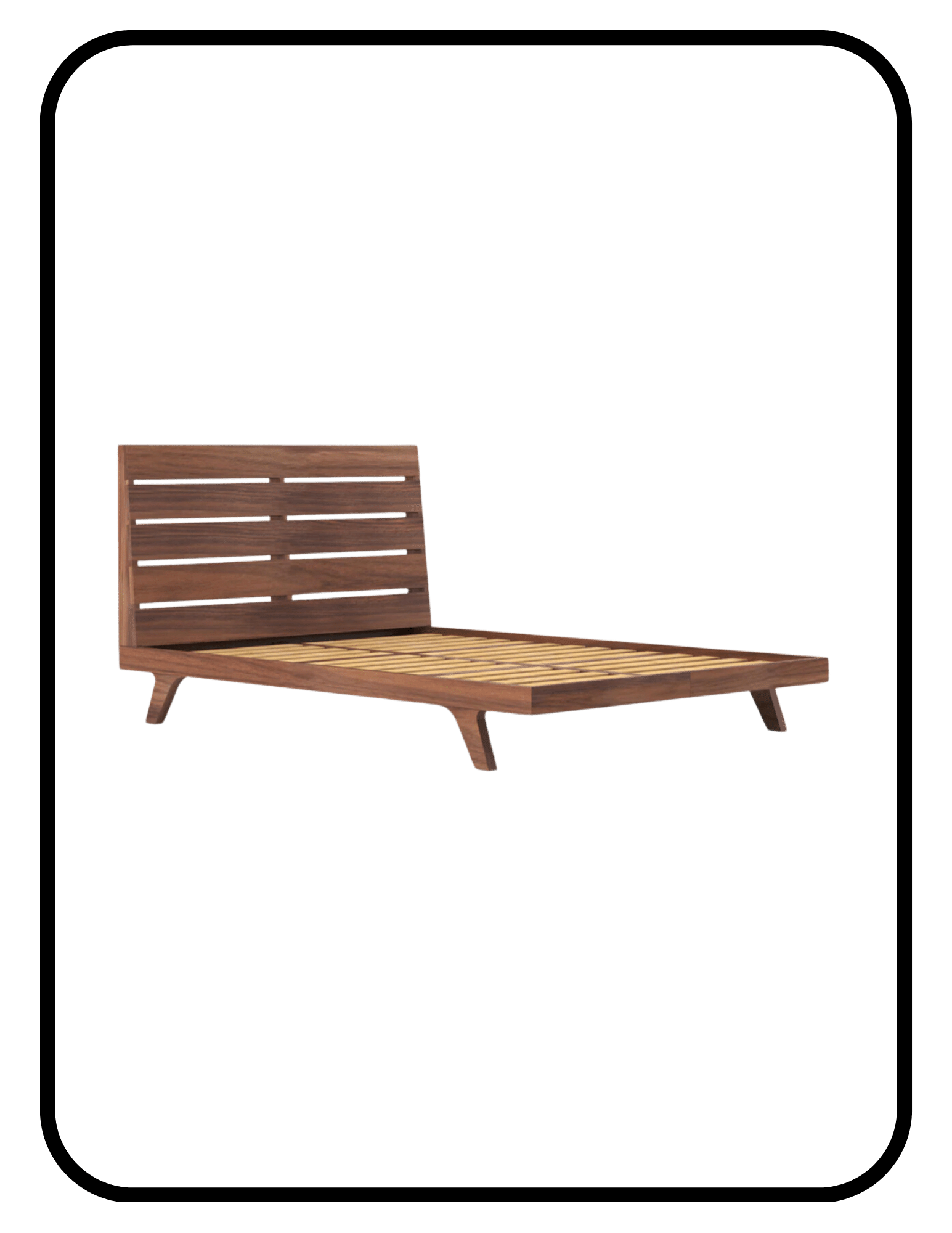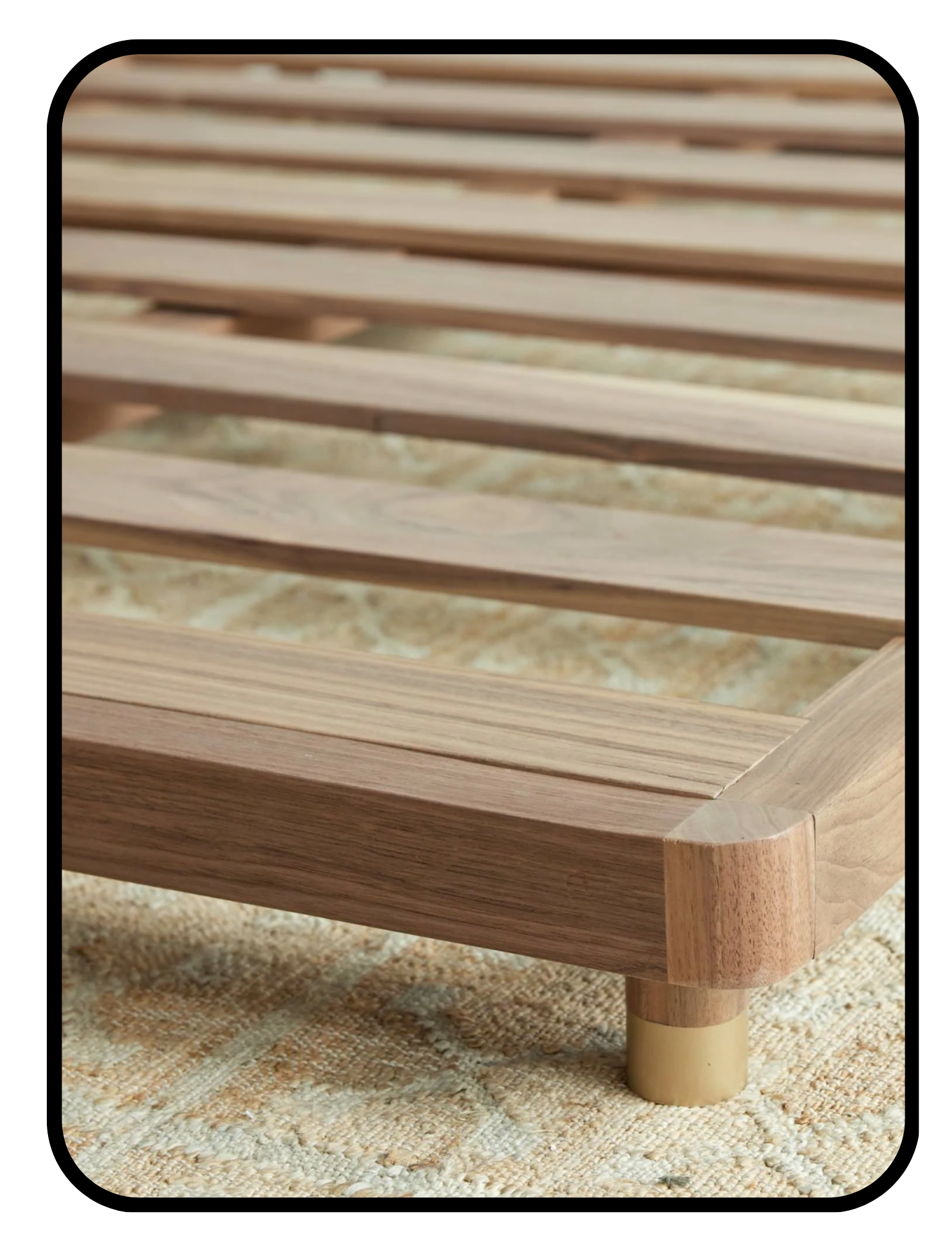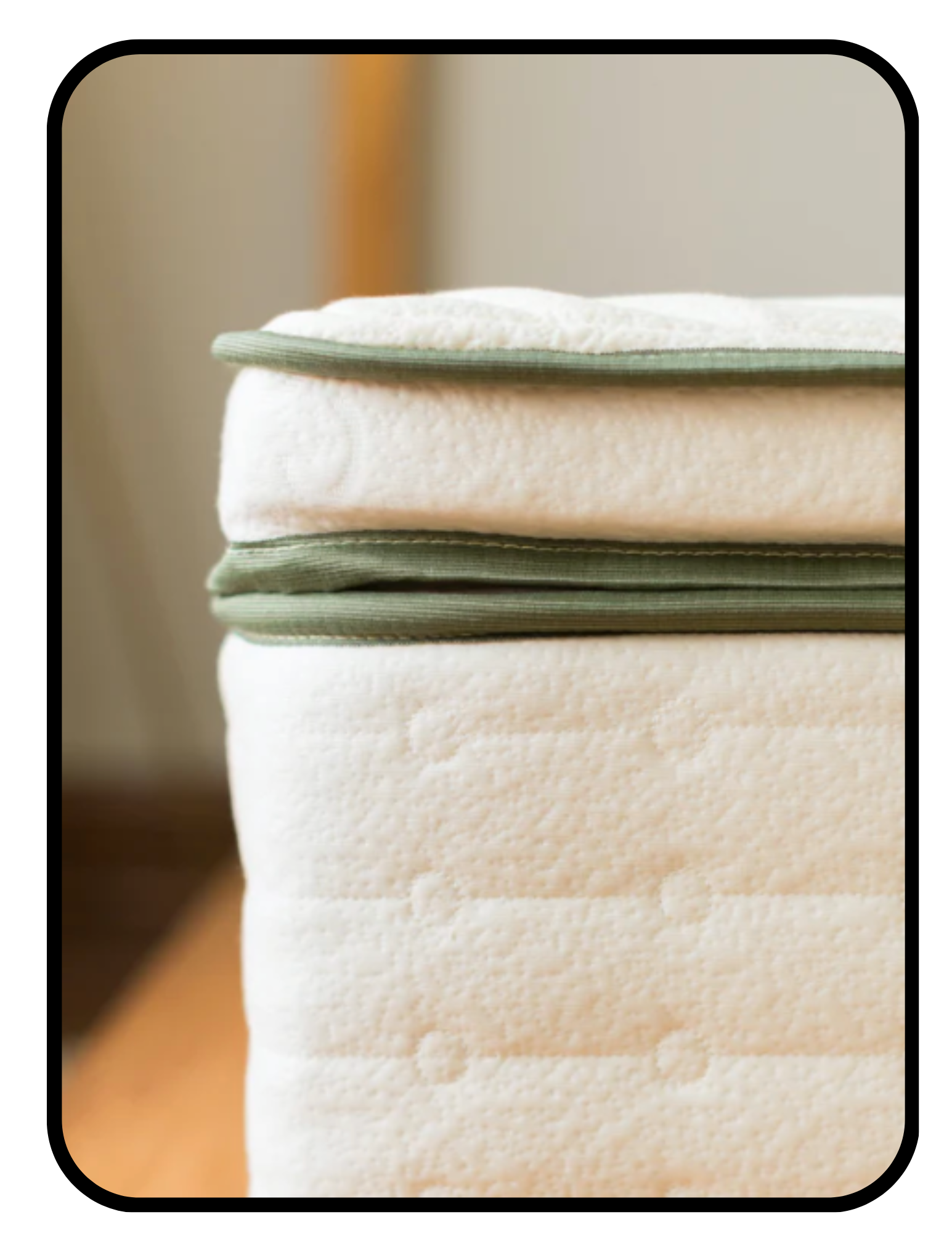Shop by Room ➜ Bedroom ➜ Bed Frames
Best Non Toxic Bed Frames
Non-toxic bed frame brands, including solid wood bed frames, and metal bed frames, with and without head boards and storage. Click the rating symbols for more information about material health.
Platform Beds with Headboards
100% solid wood bed frames finished with an all-organic flax-based wood finish that TY makes in house. If glue is needed, they use a very small amount of Titebond 3, a great non-toxic option. Can customize by adding under-bed storage drawers. They also have non toxic mid century modern beds, organic Shaker style four post beds, and more styles. Good for both human health, and an environmentally friendly bed frame.
Solid wood beds made of 100% poplar. Arrive unfinished, a good option if you’re looking to avoid stains, or want to choose a healthy paint or stain to use on your own. They use a small amount of non-toxic PVA wood glue on the dowels only, and screws elsewhere. Platform beds are great bed frames without a box spring required. Great reviews and a very affordable modern organic bed frame.
The Esmont bed frame by Savvy Rest is handcrafted of solid wood, and you can choose a linseed oil (flax) finish, or leave it unfinished, making these some of the best non toxic bed frames available. They use traditional mortise-and-tenon joinery, only using a dab of non-toxic glue occasionally. Their certifications are displayed very easily in the footer of their website, which I love for transparency reasons. A great option if you’re purchasing one of their healthy mattresses or need a bed frame on its own.
Avocado’s solid wood bed frames with head boards have a water based zero VOC finish from ECOS, another healthy brand. A great non toxic twin bed frame, full, queen, king, or Cal king. Even the cotton edging that makes the slats squeak-free is certified organic. Their City bed frame, shown above, doesn’t require any tools to assemble, and is an affordable solid wood bed frame.
Keeps’ bed frames are made mostly of solid oak, with plywood slats. They’re stained and finished with the all-in-one Rubio Monocoat, a great non-toxic brand, and they use Titebond glue, one of the best non-toxic furniture adhesives. Most importantly, they disclose all of the above freely on their website and are very responsive to follow-up questions.
These beds are made mostly with solid wood, and have plywood slats. They don’t use MDF or veneers anywhere, which is good. The beds do have GreenGuard GOLD certification, which means the stains and glues off-gas minimally, though they didn’t disclose what brands or types, so I assume standard low-VOC. Without the foam headboard, these are a healthier choice than most standard bed frames!
Get Laid makes 100% solid wood bed frames that are very customizable— you can add a little shelf, drawers underneath, or request custom sizing. Otherwise, they come in Twin, Full, Queen, King, Cal King, and even Super Emperor (!) sizes. They use water based glues and stains, and you can get one that’s unfinished, if you’d prefer to use your own. They use solid wood slats instead of plywood.
Medley’s platform bed is unique because even the slats are made of 100% solid wood. You can choose between Maple,, Oak, or Walnut wood; all are coated in a zero-VOC plant-based finish. These are some of the best wood bed frames. Medley uses non-toxic water based glues on all of their furniture. They also offer their own organic latex, wool, and cotton mattress that fits perfectly into it.
Non toxic solid wood bed frames are great, but metal bed frames have some advantages over wood ones, including not requiring glues or stains, and being very affordable. This simple Queen size metal bed frame from Amazon has a headboard and is what I use at home, because in addition to being healthy and relatively inexpensive, it’s highly rated for being sturdy and not being squeaky. No box spring required. It comes in every size, so it’s also a great option for a non toxic twin bed frame.
Are IKEA bed frames non toxic? Some are better than others. The NEIDEN bed frame is the best choice at IKEA because it’s made entirely of solid pine, which is impressive. It’s also unfinished, which is nice from a health perspective. They do use standard glues, so definitely expect off-gassing. However, once it off-gasses, this is a decent option for health. Many of their other options are made with particleboard and veneers (meaning glue and plastic).
Platform Beds without Headboards
Non Toxic Bed Frames with Storage
This twin size bed frame with storage is the best non toxic kids bed. They use zero-VOC finishes from ECOS, water-based adhesives, and are super transparent about specifics. Solid wood, with no MDF or particleboard. It comes as a trundle bed ready for a second twin mattress, or can be used for storage instead. Often sold out for all of these reasons.
Get Laid makes the most affordable 100% solid wood frames with under bed storage. They come in Twin, Full, Queen, King, Cal King, and custom sizes. They use water based glues and stains, and you can get one that’s unfinished, if you’d prefer to use your own. They use solid wood slats instead of plywood ones, which is always nice.
The Afton is a handcrafted solid wood bed frame and just like their other bed frames, you can choose a linseed oil (flax) finish, or leave it unfinished. They use traditional mortise-and-tenon joinery, so very little adhesive is needed or used. Their certifications are displayed very easily in the footer of their website, which I love for transparency reasons.
The Malibu platform bed frame by Avocado is one of the best organic modern platform bed frames without a headboard because they use zero-VOC finishes from ECOS, water-based adhesives, and are super transparent about specifics. No MDF or particleboard whatsoever. You can also add taller legs if you’re not into the low profile, or choose a lighter finish than shown above.
Non Toxic Upholstered and Soft Frame Beds
Medley Home
There are so few latex bed frames available, but the Pippen bed is the best one. It’s a non toxic channeled headboard frame that comes in all sizes, from twin to Cal King. Crafted with OEKO TEX certified wool and organic Dunlop latex instead of foam, this organic bed frame is made of solid wood and is the healthiest version of its kind.
Medley Home
The best non toxic cloud bed is Medley’s Nein bed frame. It’s handcrafted with OEKO TEX certified wool and organic Dunlop latex, this organic soft frame bed is foam-free and plastic-free, making it the healthiest version of this bed style available.
Aside from Medley, upholstered beds and cloud beds are largely made with polyurethane foam, polyester, plastic, and/or engineered wood (including Awara’s and Saatva’s). If you’re looking for a different style than Medley offers, Ecobalanza makes custom options with GOTS certified fabrics, zero-VOC glues, natural finishes, and natural rubber latex.
Best Healthy Bed Bases and Foundations
Naturepedic
Naturepedic’s organic bed base is a great box spring or bed frame alternative. This organic mattress foundation is one of the healthiest available. It’s made with solid wood and wrapped in organic cotton. In a pinch, this elevates your mattress off the floor, allowing for proper air flow to avoid moisture and mold from building up underneath. Can also be used instead of a box spring.
This King size metal bed frame from Plush Beds is affordable, with tool-free assembly. Comes in Twin, Queen, Full, and Cal King options, too. It’s squeak-free and made of reclaimed steel. Super easy to set up, and a good option on its own, or if you’re getting one of their organic mattresses.
Avocado makes the best non toxic adjustable bed foundation. It fits into your existing bed frame, if you like the look of it already, or works well on its own. You can get two split units that fit together so you can your sleeping partner can choose different comfort settings. Has a massage feature! Made of GOTS-certified organic cotton canvas, natural rubberwood legs, and a durable metal base.
More About Non-Toxic Bed Frames
Are metal bed frames bad for you?
No. The fear that spring mattresses or metal bed frames can act as EMF antennae stems from a single, poor-quality, study done in 2010 that was misinterpreted on Scientific American’s blog. It's still spreading like wildfire 14 years later, because it sounds scary, and electromagnetism is hard to understand, making it scarier. Snopes debunks it and does a great job breaking down all the details, and their thinking is very much in line with my thinking.
I am far more concerned about exposure to the known carcinogen formaldehyde used in beds made with high-VOC glues and engineered wood, and even more concerned about people worrying about something they don't need to.
I used an EMF reader in my house to show you the readings near my microwave, WiFi router, on a metal bed frame, and in the middle of the bed where your body would be. Readings remain at 0.0 when the electronics are off, when you step a few feet away from the electronics even when they’re turned on, and are always at 0.0 everywhere on the bed and bed frame. Watch the video below:
The purpose of this video is to show you your relative risk, not to stir up debate about whether all EMFs are safe or all EMFs are dangerous. This a big conversation with a lot of nuance (that typically tends to veer toward extremes.)
If you are concerned about EMF exposure, I would recommend prioritizing standing away from the microwave when it’s on, turning off your WiFi router at night, or hiring a professional to take readings for your home. I would worry less about your bed frame.
If you are not concerned about EMF exposure, then there is no need to start being concerned about your bed frame now.
What material is best for a bed frame?
Solid wood or metal are the best materials for bed frames. Avoid fake woods, like MDF, particleboard, or other engineered woods, which contain high-VOC glues containing toxic solvents and often formaldehyde. Many have a veneer attached to them; this is a thin piece of plastic that looks like wood glued on to the outside. The less plastic and solvent exposure, the better.
What is FSC certified wood?
FSC, or the Forest Stewardship Council certification, is focused on responsible management of forests. For wood, it means that the trees it comes from meet forest management standards, indigenous people’s rights are respected when harvesting, and old growth forests are not disturbed. It’s a fantastic certification in terms of our environment and community, but FSC-certified wood can still be treated or finished with many other chemicals that harm your health.
What is plywood?
Plywood is made of many layers of super-thin pieces of solid wood. Each layer’s grain is stacked perpendicular to the one above and below it, and all the layers are attached with an adhesive binder (plywood can have up to 3.5% binder by weight). Alternating the wood grain at perpendicular angles makes plywood even stronger than wood, and is why you see it used for home construction. After the layers are glued together, heat and pressure are applied to make a smooth plywood panel.
Are wood stains toxic?
Wood stains are often, but not always, toxic to health. It depends on the kind you use.
A completely natural wood stain like coffee is completely safe, but of course, this isn’t common in store-bought furniture. Water-based wood stains are relatively non-toxic, especially ones with certifications like GreenSeal-11 ensuring the most harmful additives are avoided. Ones without VOCs, antimicrobials, chemical drying agents, or heavy metals are a better choice. Oil-based wood stains with standard chemicals that release high VOCs are quite harmful to health.
What is Green Seal 11 (GS-11) certification?
Green Seal’s GS-11 certification means that a wood stain or finish doesn’t have the worst or most harmful additives in it. This is because VOCs are not the only dangerous part of stains, adhesives, and finishes— there are many chemicals that do not smell that are issues for health. This is what the GS-11 covers.
GS-11 limit the levels of VOCs, as well as carcinogens, reproductive toxins, triclosan, phthalates, heavy metals, and others. You can see the full list of what they limit here.
What is the difference between wood stain and wood finish?
Wood stains add color to natural wood, while a finish protects it.
Why are oil-based finishes, but water-based stains, better?
Natural, oil-based finishes like linseed oil, hemp oil, or tung oil are minimally processed, and very low in VOCs. Water-based finishes often contain high-VOC, toxic solvents to make them work better.
On the other hand, natural, oil-based stains typically have higher VOCs, whereas their water-based counterparts, have less.
What are plant-based oil finishes?
Linseed, hemp, and tung oil are types of plant-based oil finishes. Linseed oil comes from the flax plant. Hemp oil comes from the cannabis plant. Tung oil comes from the Tung tree (Vernicia fordii), native to China, Myanmar, and North Vietnam.
What are solvent-based finishes?
Varnish, acrylic, synthetic lacquer, and urethane-based finishes all require a much higher solvent concentration than water-based finishes, so are quite high in VOCs that irritate your respiratory tract. They also often contain carcinogenic chemicals.
What is GreenGuard GOLD certified?
GreenGuard certification is useful for finding wood products that do not off-gas VOCs excessively. To meet the standard GreenGuard level, VOCs must be less than 500 ug/m3. To meet the elevated GreenGuard GOLD level, VOCs must be less than 220 ug/m3.
A GreenGuard certification does not mean it is healthy, and it does not mean there are no VOCs off-gassing from the product. Sometimes I see companies say “It’s GreenGuard so it’s healthy!” which is simply not true. There are harmful chemicals in stains, glues, and finishes that don’t off-gas as VOCs.
That said, it is still a useful certification when choosing between a standard wood product and one with GreenGuard certification. It is still a step in the right direction.
What does zero VOC mean?
There is no formal set of rules for what qualifies as zero VOC, and different companies and standards define it differently. Typically, zero-VOC or no-VOC means there are less than 5 grams of VOCs per liter and the smell is undetectable (though not all VOCs have a smell!) Ideally, a company that states their products are no- or low- VOC also has certifications from Green Seal, GreenGuard, or SCS Indoor Advantage verifying their claims are true.
What does low VOC mean?
There is no formal set of rules for what qualifies as low VOC, and different companies and standards define it differently. Typically, low-VOC means there are less than 50 grams of VOCs per liter of paint. Ideally, a company that states their products are no- or low- VOC also has certifications from Green Seal, GreenGuard, or SCS Indoor Advantage verifying their claims are true.
Is sleeping without a bed frame bad for you?
No, but it may be bad for your mattress, which eventually be bad for you. While sleeping with your mattress directly on the floor provides a firm, supportive surface, it doesn’t allow for any air to flow under the mattress, and bacteria and mold can easily build up. At a minimum, I recommend getting a basic foundation to provide airflow but still be minimalistic.
Shop by Room ➜ Bedroom ➜ Bed Frames









































